MAZDA MODEL 6 2016 Owners Manual (in English)
Manufacturer: MAZDA, Model Year: 2016, Model line: MODEL 6, Model: MAZDA MODEL 6 2016Pages: 614, PDF Size: 12.82 MB
Page 211 of 614
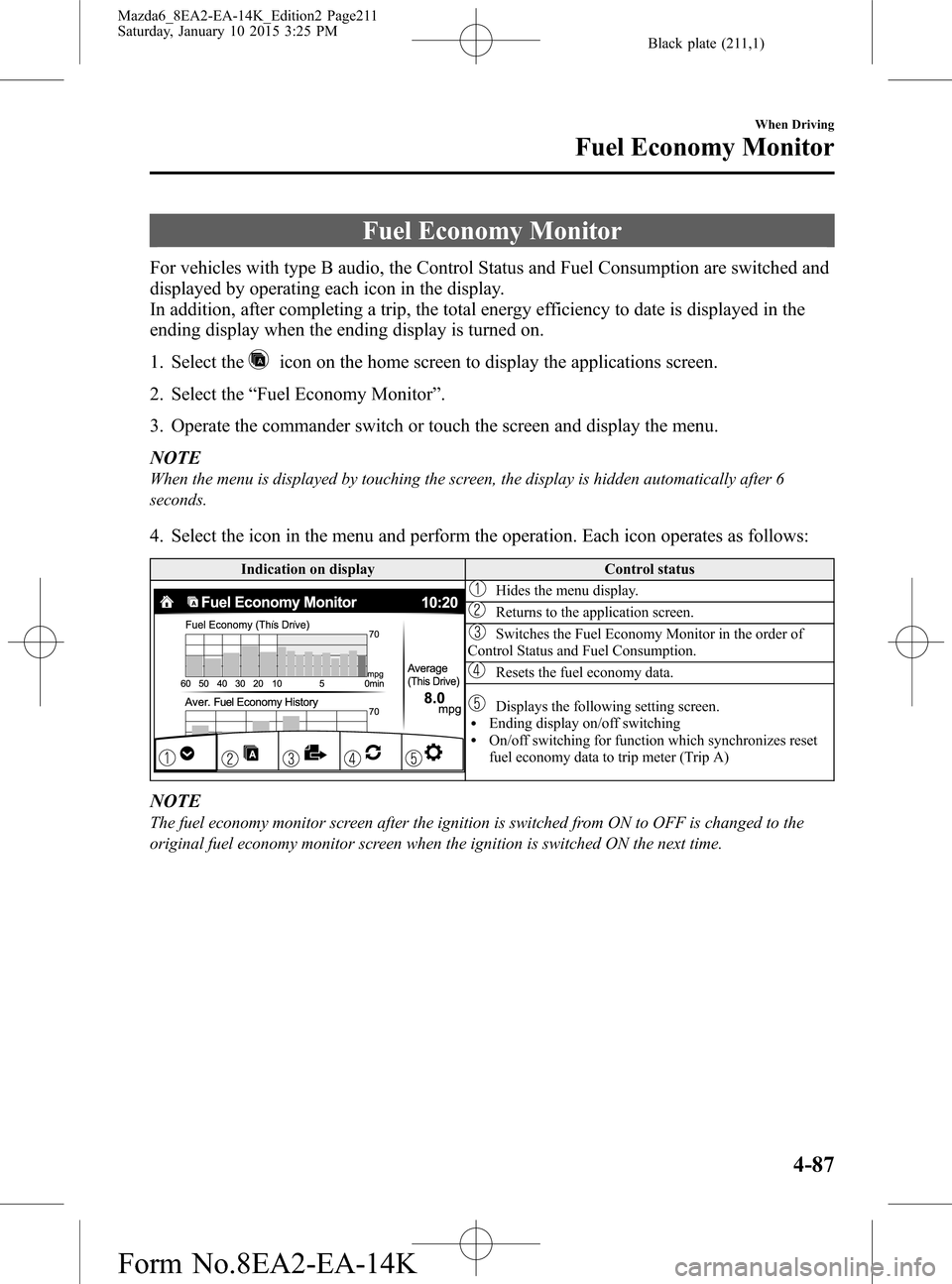
Black plate (211,1)
Fuel Economy Monitor
For vehicles with type B audio, the Control Status and Fuel Consumption are switched and
displayed by operating each icon in the display.
In addition, after completing a trip, the total energy efficiency to date is displayed in the
ending display when the ending display is turned on.
1. Select the
icon on the home screen to display the applications screen.
2. Select the“Fuel Economy Monitor”.
3. Operate the commander switch or touch the screen and display the menu.
NOTE
When the menu is displayed by touching the screen, the display is hidden automatically after 6
seconds.
4. Select the icon in the menu and perform the operation. Each icon operates as follows:
Indication on display Control status
Hides the menu display.
Returns to the application screen.
Switches the Fuel Economy Monitor in the order of
Control Status and Fuel Consumption.
Resets the fuel economy data.
Displays the following setting screen.lEnding display on/off switchinglOn/off switching for function which synchronizes reset
fuel economy data to trip meter (Trip A)
NOTE
The fuel economy monitor screen after the ignition is switched from ON to OFF is changed to the
original fuel economy monitor screen when the ignition is switched ON the next time.
When Driving
Fuel Economy Monitor
4-87
Mazda6_8EA2-EA-14K_Edition2 Page211
Saturday, January 10 2015 3:25 PM
Form No.8EA2-EA-14K
Page 212 of 614
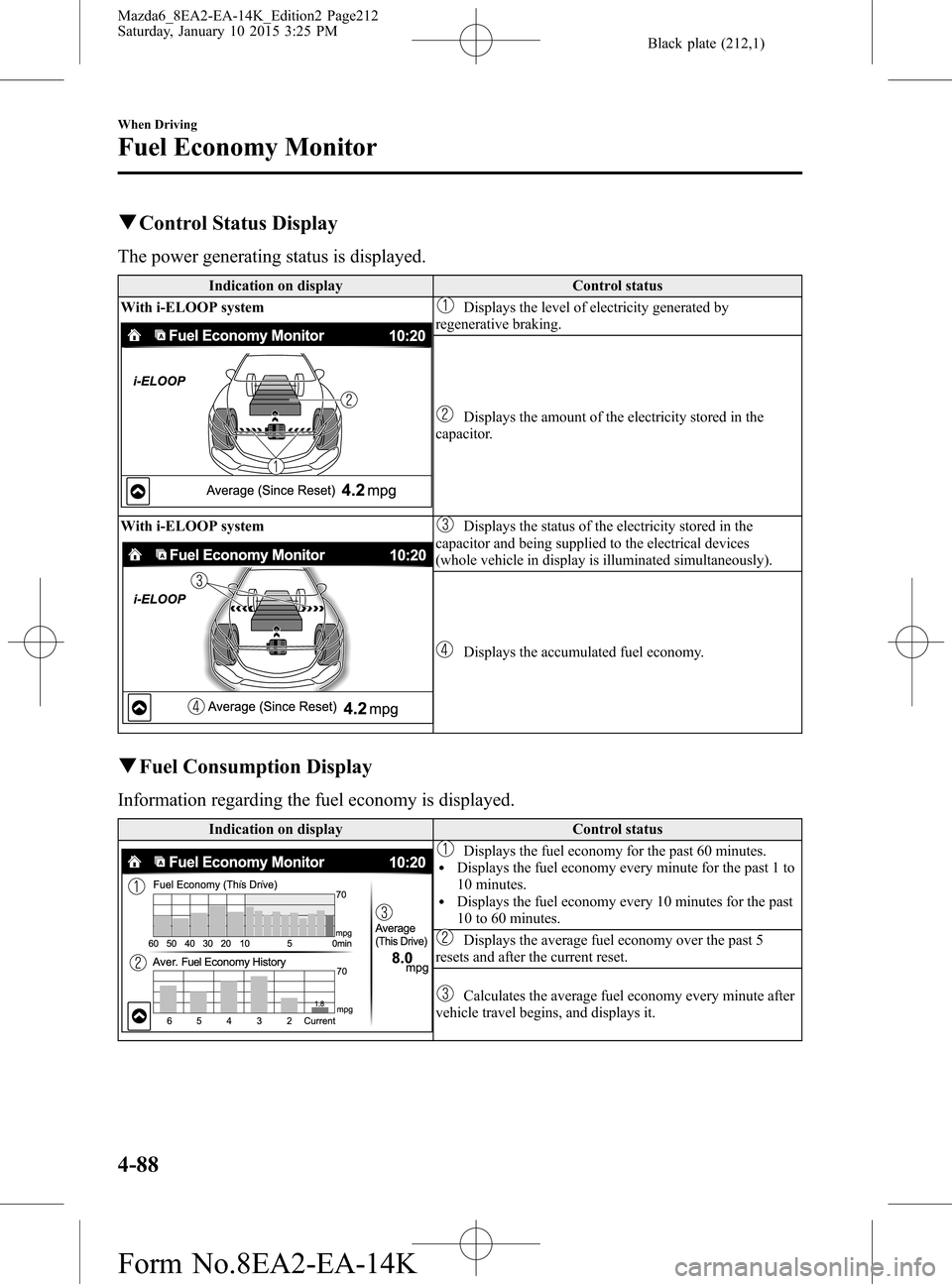
Black plate (212,1)
qControl Status Display
The power generating status is displayed.
Indication on display Control status
With i-ELOOP system
Displays the level of electricity generated by
regenerative braking.
Displays the amount of the electricity stored in the
capacitor.
With i-ELOOP system
Displays the status of the electricity stored in the
capacitor and being supplied to the electrical devices
(whole vehicle in display is illuminated simultaneously).
Displays the accumulated fuel economy.
qFuel Consumption Display
Information regarding the fuel economy is displayed.
Indication on display Control status
Displays the fuel economy for the past 60 minutes.lDisplays the fuel economy every minute for the past 1 to
10 minutes.
lDisplays the fuel economy every 10 minutes for the past
10 to 60 minutes.
Displays the average fuel economy over the past 5
resets and after the current reset.
Calculates the average fuel economy every minute after
vehicle travel begins, and displays it.
4-88
When Driving
Fuel Economy Monitor
Mazda6_8EA2-EA-14K_Edition2 Page212
Saturday, January 10 2015 3:25 PM
Form No.8EA2-EA-14K
Page 213 of 614
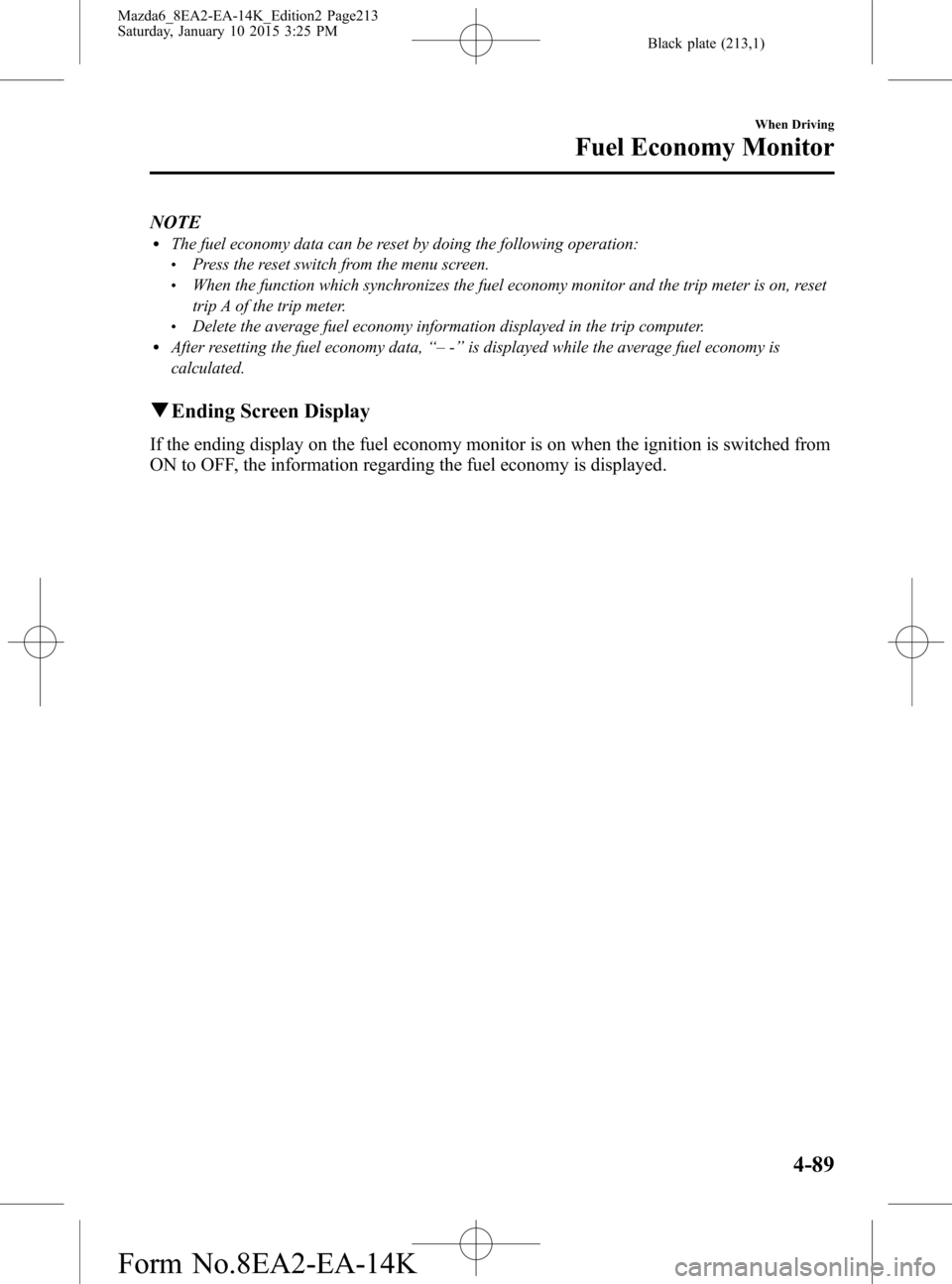
Black plate (213,1)
NOTElThe fuel economy data can be reset by doing the following operation:lPress the reset switch from the menu screen.lWhen the function which synchronizes the fuel economy monitor and the trip meter is on, reset
trip A of the trip meter.
lDelete the average fuel economy information displayed in the trip computer.lAfter resetting the fuel economy data,“–-”is displayed while the average fuel economy is
calculated.
qEnding Screen Display
If the ending display on the fuel economy monitor is on when the ignition is switched from
ON to OFF, the information regarding the fuel economy is displayed.
When Driving
Fuel Economy Monitor
4-89
Mazda6_8EA2-EA-14K_Edition2 Page213
Saturday, January 10 2015 3:25 PM
Form No.8EA2-EA-14K
Page 214 of 614
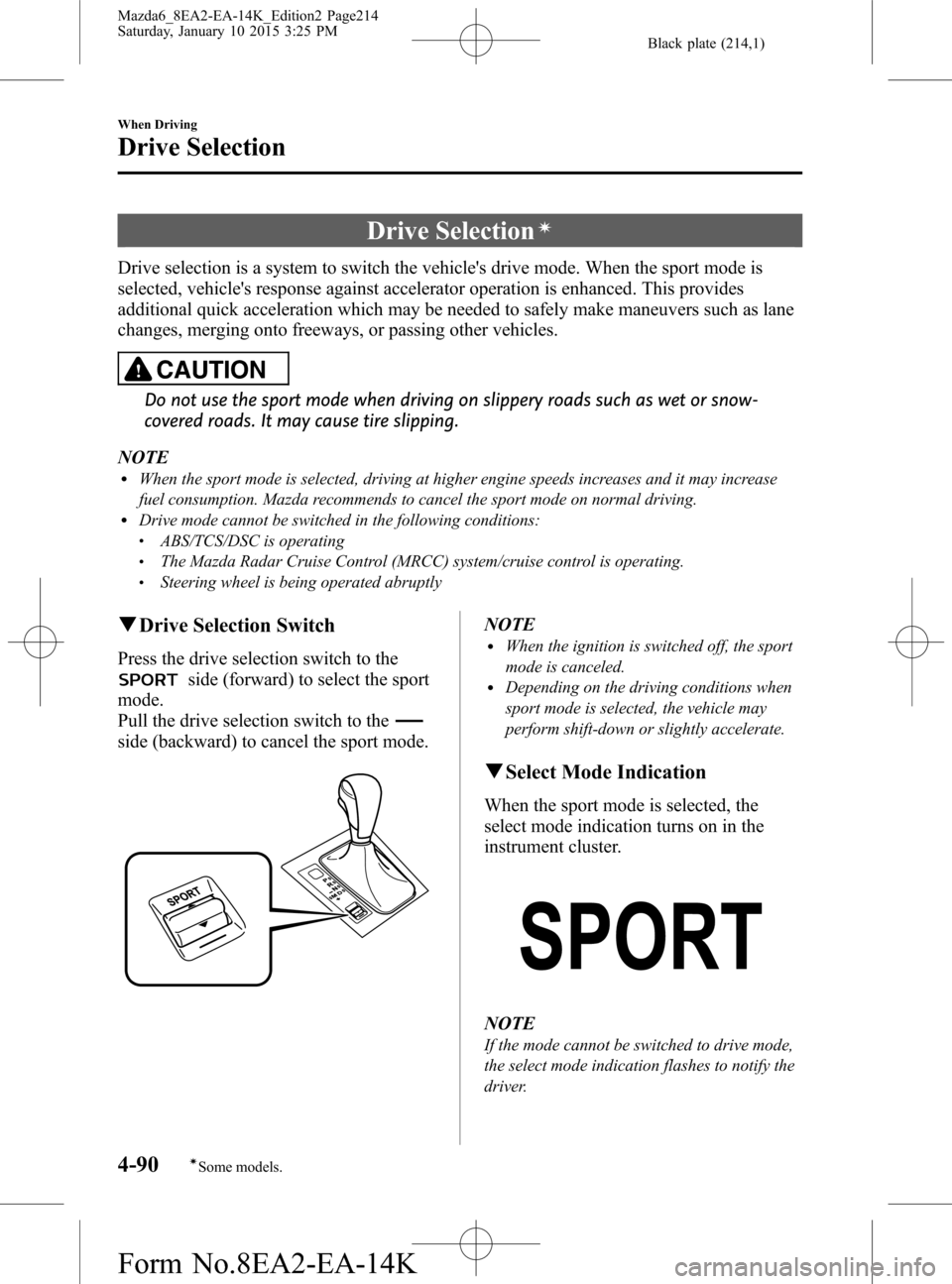
Black plate (214,1)
Drive Selectioní
Drive selection is a system to switch the vehicle's drive mode. When the sport mode is
selected, vehicle's response against accelerator operation is enhanced. This provides
additional quick acceleration which may be needed to safely make maneuvers such as lane
changes, merging onto freeways, or passing other vehicles.
CAUTION
Do not use the sport mode when driving on slippery roads such as wet or snow-
covered roads. It may cause tire slipping.
NOTE
lWhen the sport mode is selected, driving at higher engine speeds increases and it may increase
fuel consumption. Mazda recommends to cancel the sport mode on normal driving.
lDrive mode cannot be switched in the following conditions:lABS/TCS/DSC is operatinglThe Mazda Radar Cruise Control (MRCC) system/cruise control is operating.lSteering wheel is being operated abruptly
qDrive Selection Switch
Press the drive selection switch to the
side (forward) to select the sport
mode.
Pull the drive selection switch to the
side (backward) to cancel the sport mode.
NOTElWhen the ignition is switched off, the sport
mode is canceled.
lDepending on the driving conditions when
sport mode is selected, the vehicle may
perform shift-down or slightly accelerate.
qSelect Mode Indication
When the sport mode is selected, the
select mode indication turns on in the
instrument cluster.
NOTE
If the mode cannot be switched to drive mode,
the select mode indication flashes to notify the
driver.
4-90
When Driving
íSome models.
Drive Selection
Mazda6_8EA2-EA-14K_Edition2 Page214
Saturday, January 10 2015 3:25 PM
Form No.8EA2-EA-14K
Page 215 of 614

Black plate (215,1)
Power Steering
lPower steering is only operable when
the engine is running. If the engine is
off or if the power steering system is
inoperable, you can still steer, but it
requires more physical effort.
If the steering feels stiffer than usual
during normal driving or the steering
vibrates, consult an Authorized Mazda
Dealer.
lFor vehicles with the type A instrument
cluster, check the vehicle condition or
have the vehicle inspected at an
Authorized Mazda Dealer according to
the indication.
lA system malfunction or operation
conditions are indicated by a warning.
In addition, the buzzer may also
activate depending on the system
abnormality or operation condition.
Refer to Warning/Indicator Lights on
page 4-22.
Refer to Warning Sound is Activated
on page 7-33.
CAUTION
Never hold the steering wheel to the
extreme left or right for more than 5
seconds with the engine running.
This could damage the power
steering system.
When Driving
Power Steering
4-91
Mazda6_8EA2-EA-14K_Edition2 Page215
Saturday, January 10 2015 3:25 PM
Form No.8EA2-EA-14K
Page 216 of 614

Black plate (216,1)
i-ACTIVSENSEí
i-ACTIVSENSE is a collective term covering a series of advanced safety and driver
support systems which make use of a Forward Sensing Camera (FSC) and radar sensors.
These systems consist of active safety and pre-crash safety systems.
These systems are designed to assist the driver in safer driving by reducing the load on the
driver and helping to avert collisions or reduce their severity. However, because each
system has its limitations, always drive carefully and do not rely solely on the systems.
qActive Safety Technology
Active Safety Technology supports safer driving by helping the driver to recognize
potential hazards and avert accidents.
Driver awareness support systems
Nighttime visibility
Adaptive Front Lighting System (AFS) ................................................................. page 4-94
High Beam Control System (HBC) ........................................................................ page 4-95
Forward/rear detection
Lane Departure Warning System (LDWS) ............................................................. page 4-98
Blind Spot Monitoring (BSM) System ................................................................. page 4-104
Inter-vehicle distance recognition
Distance Recognition Support System (DRSS) ................................................... page 4-109
Rear obstruction detection when leaving a parking space
Rear Cross Traffic Alert (RCTA) ......................................................................... page 4-112
Driver Support Systems
Inter-vehicle distance
Mazda Radar Cruise Control (MRCC) ................................................................. page 4-117
qPre-Crash Safety Technology
Pre-crash safety technology is designed to assist the driver in averting collisions or reduce
their severity in situations where they cannot be avoided.
Collision damage reduction in low vehicle speed range
Forward driving
Smart City Brake Support (SCBS) ....................................................................... page 4-127
4-92
When Driving
íSome models.
i-ACTIVSENSE
Mazda6_8EA2-EA-14K_Edition2 Page216
Saturday, January 10 2015 3:25 PM
Form No.8EA2-EA-14K
Page 217 of 614

Black plate (217,1)
Collision damage reduction in medium/high speed range
Smart Brake Support (SBS) ................................................................................. page 4-132
qCamera and Sensors
Forward Sensing Camera (FSC)
The Forward Sensing Camera (FSC) detects lane indications and recognizes headlights,
taillights and city lights during nighttime driving. The following systems also use the
Forward Sensing Camera (FSC).
lHigh Beam Control system (HBC)lLane Departure Warning System (LDWS)lSmart Brake Support (SBS)
The Forward Sensing Camera (FSC) is installed at the top of the windshield near the
rearview mirror.
Refer to Forward Sensing Camera (FSC) on page 4-135.
Radar sensor (front)
The radar sensor (front) functions by detecting the radio waves reflected off a vehicle
ahead sent from the radar sensor. The following systems also use the radar sensor (front).
lMazda Radar Cruise Control (MRCC)lDistance Recognition Support System (DRSS)lSmart Brake Support (SBS)
The radar sensor (front) is mounted behind the radiator grille.
Refer to Radar Sensor (Front) on page 4-138.
Laser sensor (front)
The laser sensor (front) emits a near-infrared laser beam and receives the beam reflected off
the reflective surface of a vehicle in front, and the detected beam is then used for
measurement. The following systems also use the laser sensor (front).
lSmart Brake Support (SBS)lSmart City Brake Support (SCBS)
The laser sensor (front) is installed at the top of the windshield near the rearview mirror.
Refer to Laser Sensor (Front) on page 4-141.
Radar sensors (rear)
The radar sensors (rear) function by detecting the radio waves reflected off a vehicle
approaching from the rear or an obstruction sent from the radar sensors. The following
systems also use the radar sensors (rear).
lBlind Spot Monitoring (BSM) SystemlRear Cross Traffic Alert (RCTA)
The radar sensors (rear) are installed inside the rear bumper, one each on the left and right
sides.
Refer to Radar Sensors (Rear) on page 4-143.
When Driving
i-ACTIVSENSE
4-93
Mazda6_8EA2-EA-14K_Edition2 Page217
Saturday, January 10 2015 3:25 PM
Form No.8EA2-EA-14K
Page 218 of 614
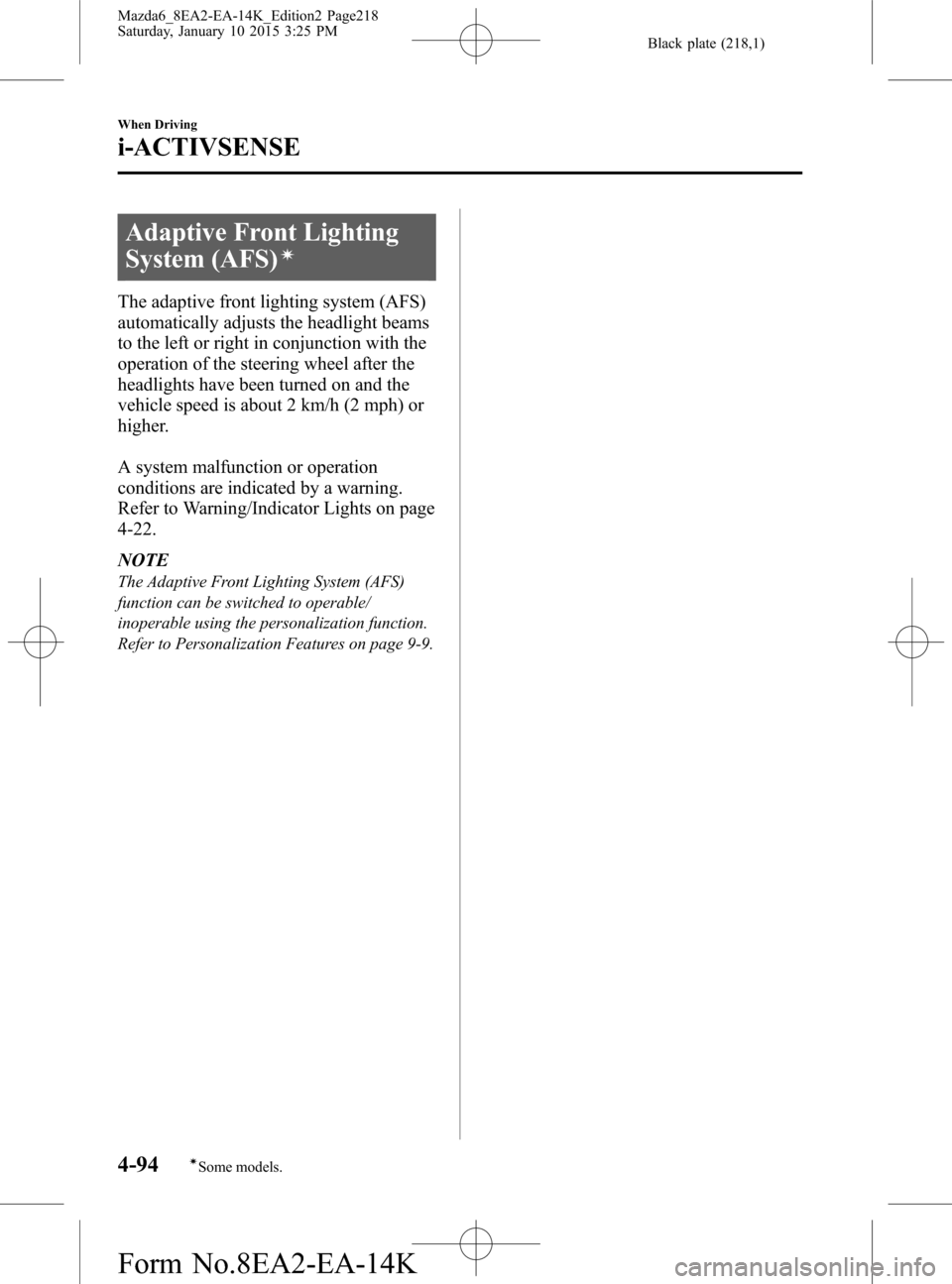
Black plate (218,1)
Adaptive Front Lighting
System (AFS)
í
The adaptive front lighting system (AFS)
automatically adjusts the headlight beams
to the left or right in conjunction with the
operation of the steering wheel after the
headlights have been turned on and the
vehicle speed is about 2 km/h (2 mph) or
higher.
A system malfunction or operation
conditions are indicated by a warning.
Refer to Warning/Indicator Lights on page
4-22.
NOTE
The Adaptive Front Lighting System (AFS)
function can be switched to operable/
inoperable using the personalization function.
Refer to Personalization Features on page 9-9.
4-94
When Driving
íSome models.
i-ACTIVSENSE
Mazda6_8EA2-EA-14K_Edition2 Page218
Saturday, January 10 2015 3:25 PM
Form No.8EA2-EA-14K
Page 219 of 614
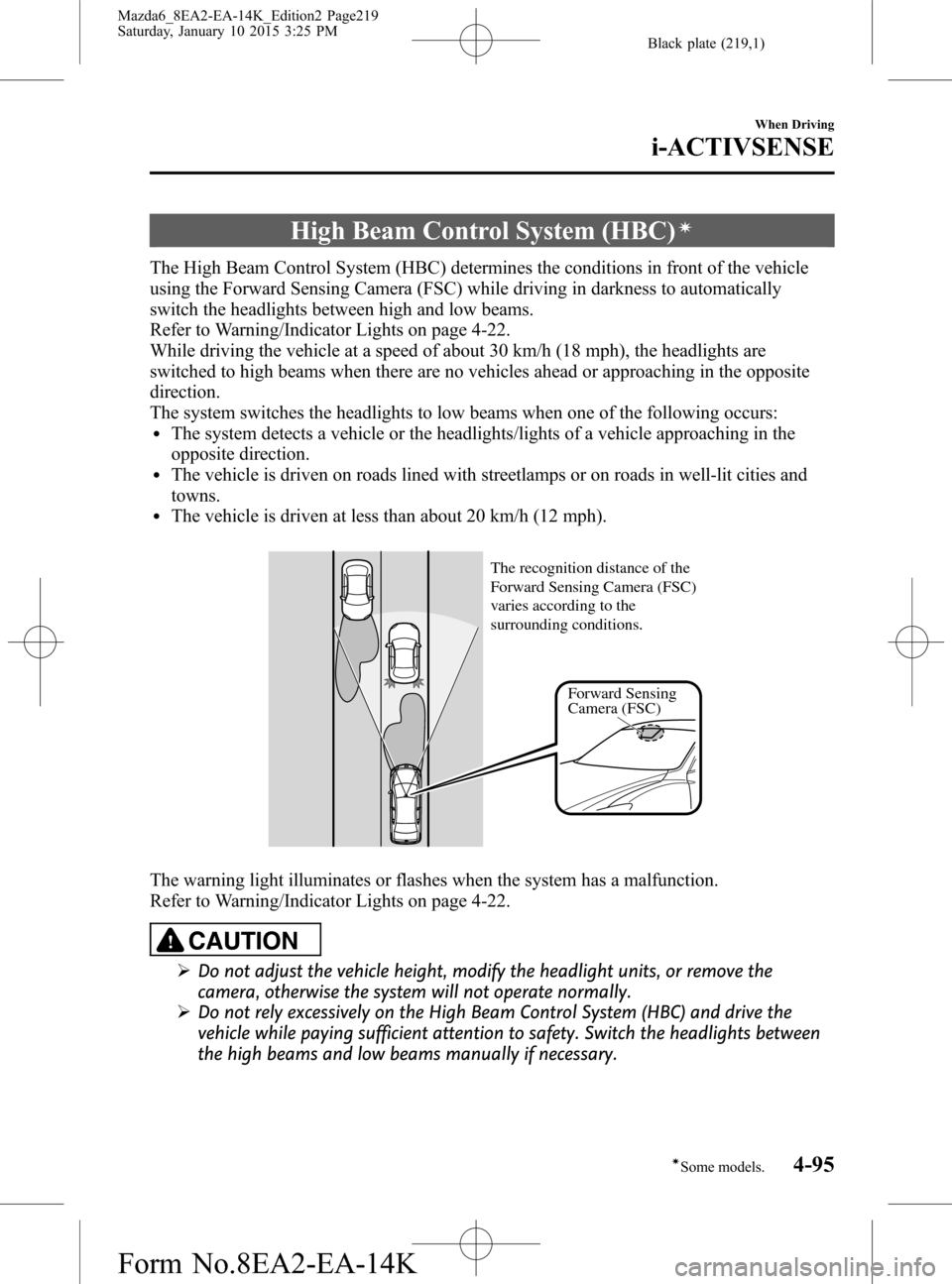
Black plate (219,1)
High Beam Control System (HBC)í
The High Beam Control System (HBC) determines the conditions in front of the vehicle
using the Forward Sensing Camera (FSC) while driving in darkness to automatically
switch the headlights between high and low beams.
Refer to Warning/Indicator Lights on page 4-22.
While driving the vehicle at a speed of about 30 km/h (18 mph), the headlights are
switched to high beams when there are no vehicles ahead or approaching in the opposite
direction.
The system switches the headlights to low beams when one of the following occurs:
lThe system detects a vehicle or the headlights/lights of a vehicle approaching in the
opposite direction.
lThe vehicle is driven on roads lined with streetlamps or on roads in well-lit cities and
towns.
lThe vehicle is driven at less than about 20 km/h (12 mph).
Forward Sensing
Camera (FSC) The recognition distance of the
Forward Sensing Camera (FSC)
varies according to the
surrounding conditions.
The warning light illuminates or flashes when the system has a malfunction.
Refer to Warning/Indicator Lights on page 4-22.
CAUTION
ØDo not adjust the vehicle height, modify the headlight units, or remove the
camera, otherwise the system will not operate normally.
ØDo not rely excessively on the High Beam Control System (HBC) and drive the
vehicle while paying sufficient attention to safety. Switch the headlights between
the high beams and low beams manually if necessary.
When Driving
i-ACTIVSENSE
4-95íSome models. Mazda6_8EA2-EA-14K_Edition2 Page219
Saturday, January 10 2015 3:25 PM
Form No.8EA2-EA-14K
Page 220 of 614
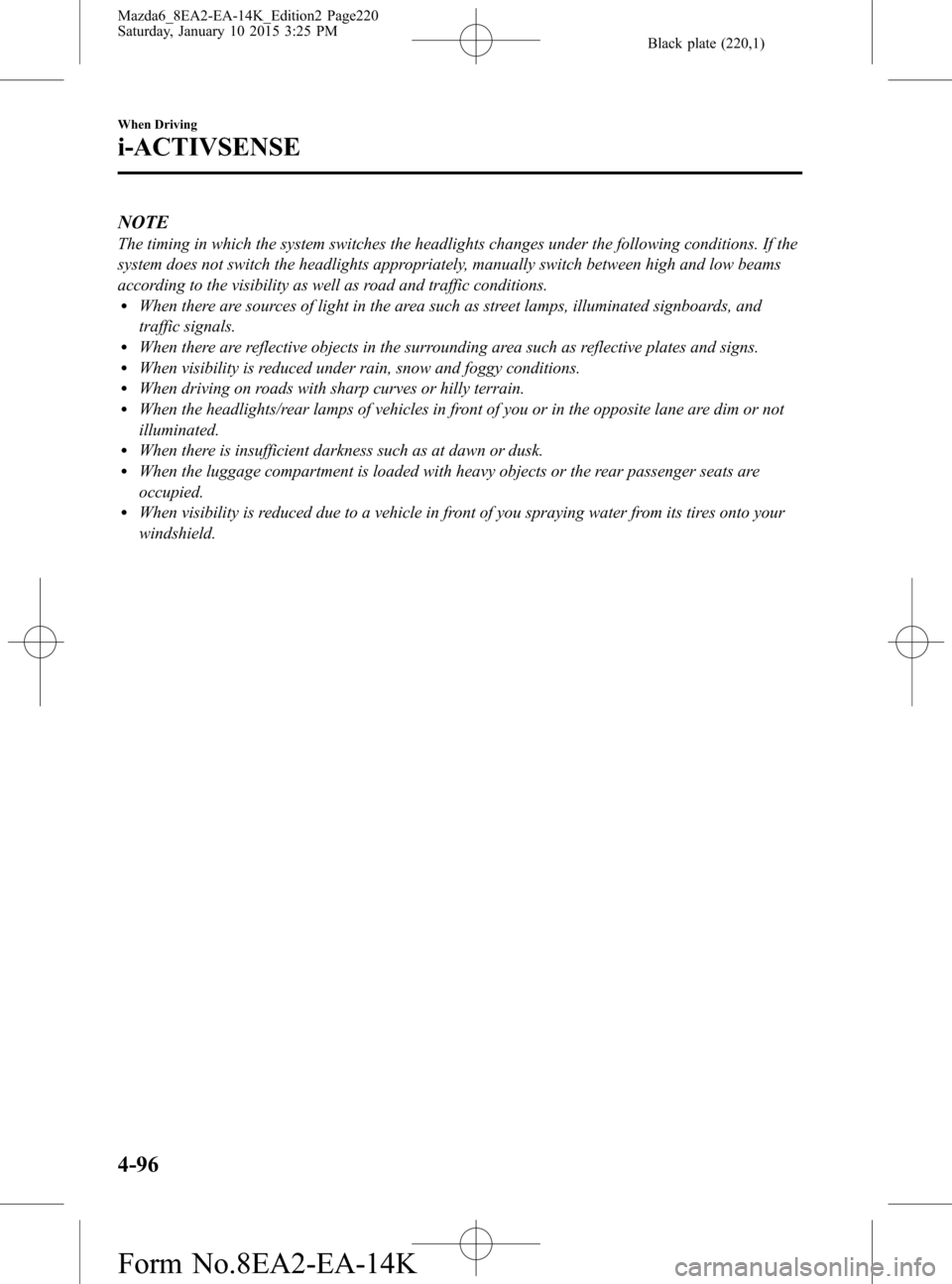
Black plate (220,1)
NOTE
The timing in which the system switches the headlights changes under the following conditions. If the
system does not switch the headlights appropriately, manually switch between high and low beams
according to the visibility as well as road and traffic conditions.
lWhen there are sources of light in the area such as street lamps, illuminated signboards, and
traffic signals.
lWhen there are reflective objects in the surrounding area such as reflective plates and signs.lWhen visibility is reduced under rain, snow and foggy conditions.lWhen driving on roads with sharp curves or hilly terrain.lWhen the headlights/rear lamps of vehicles in front of you or in the opposite lane are dim or not
illuminated.
lWhen there is insufficient darkness such as at dawn or dusk.lWhen the luggage compartment is loaded with heavy objects or the rear passenger seats are
occupied.
lWhen visibility is reduced due to a vehicle in front of you spraying water from its tires onto your
windshield.
4-96
When Driving
i-ACTIVSENSE
Mazda6_8EA2-EA-14K_Edition2 Page220
Saturday, January 10 2015 3:25 PM
Form No.8EA2-EA-14K